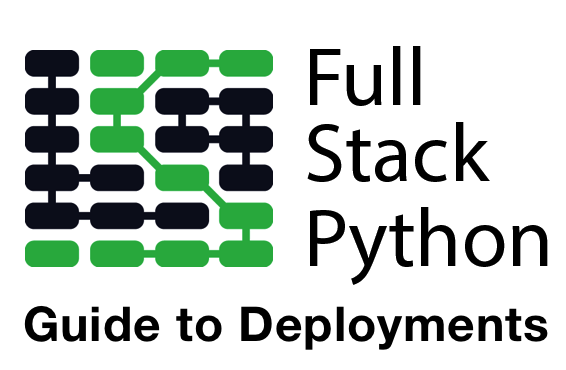Operating Systems
An operating system runs on the server or virtual server and controls access to computing resources. The operating system also includes a way to install programs necessary for running your Python web application.
Why are operating systems necessary?
An operating system makes many of the computing tasks we take for granted easy. For example, the operating system enables writing to files, communicating over a network and running multiple programs at once. Otherwise you'd need to control the CPU, memory, network, graphics card, and many other components with your own low-level implementation.
Without using an existing operating system like Linux, Mac OS X or Windows, you'd be forced to write a new operating system as part of your web application. It would be impossible to write features for your Python web application because you'd be too busy hunting down a memory leak in your assembly code, if you even were able to get that far.
Fortunately, the open source community provides Linux to the Python world as a rock solid free operating system for running our applications.
Recommended operating systems
The only recommended operating system for production Python web stack deployments is Linux. There are several Linux distributions commonly used for running production servers. Ubuntu Long Term Support (LTS) releases, Red Hat Enterprise Linux, and CentOS are all viable options.
Mac OS X is fine for development activities. Windows and Mac OS X are not appropriate for production deployments unless there is a major reason why you must use them in lieu of Linux.
Ubuntu
Ubuntu is a Linux distribution packaged by the Canonical Ltd company. Ubuntu uses the Debian distribution as a base for packages, including the aptitude package manager. For desktop versions of Ubuntu, GNOME (until the 11.04 release) or Unity (11.10 through current) is bundled with the distribution to provide a user interface.
Ubuntu Long Term Support (LTS) releases are the recommended versions to use for deployments. LTS versions receive five years of post-release updates from Canonical. Every two years, Canonical creates a new LTS release, which allows for an easy upgrade path as well as flexibility in skipping every other LTS release if necessary. As of April 2016, 16.04 Xenial Xerus is the latest Ubuntu LTS release. Xenial Xerus includes Python 3.5 as its default Python version, which is a major update compared with 2.7 in Ubuntu 14.04 LTS.
Ubuntu Python Packages
There are several Aptitude packages found on Linux servers running a Python stack. These packages are:
-
python-dev for header files and static library for Python
-
python-virtualenv for creating and managing Python virtualenvs to isolate library dependencies
Red Hat and CentOS
Red Hat Enterprise Linux (RHEL) and Community ENTerprise Operating System (CentOS) are the same distribution. The primary difference between the two is that CentOS is an open source, liberally licensed free derivative of RHEL.
RHEL and CentOS use a different package manager and command-line interface from Debian-based Linux distributions: RPM Package Manager (RPM) and the Yellowdog Updater, Modified (YUM). RPM has a specific .rpm file format to handle the packaging and installation of libraries and applications. YUM provides a command-line interface for interacting with the RPM system.
Operating system resources
-
What is a Linux distribution and how do I choose the right one?
-
Lifehacker's guide to choosing a Linux distro.
-
Linux Journey is a really well designed curriculum for learning Linux basics such as the command line, package management, text handling. There are also courses for more advanced topics such as how the kernel works, setting up logging and device management.
-
The Ops School curriculum is a comprehensive resource for learning about Linux fundamentals and how to perform the work that system administrators typically handle.
-
Since Linux is your go-to production operating system, it's important to get comfortable with the Unix/Linux commands and philosophy. Study up on this introduction to Unix tutorial to become more familiar with the operating system.
-
First 5 Minutes on a Server shows the first several security steps that should be done manually or automatically on any server you stand up.
-
Digital Ocean has a detailed walkthrough for setting up Python web applications on Ubuntu.
-
linux-internals is a series of posts about how Linux works under the covers, starting from the low level booting process.
Operating system learning checklist
-
Choose either a Debian-based Linux distribution such as Ubuntu or a Fedora-based distribution like CentOS.
-
Harden the security through a few basic steps. Install basic security packages such as fail2ban and unattended-upgrades. Create a new user account with sudo privileges and disable root logins. Disable password-only logins and use a public-private keypair instead. Read more about hardening systems in the resources listed below.
-
Install Python-specific packages to prepare the environment for running a Python application. Which packages you'll need to install depends on the distribution you've selected.
-
Read up on web servers as installing one will be the next step in the deployment process.
After setting up your OS you should configure a web server.

Searching for a complete, step-by-step deployment walkthrough? Learn more about The Full Stack Python Guide to Deployments book.
Email Updates
Operating Systems
Need more detailed tutorials than you see here? Learn more about The Full Stack Python Guide to Deployments book.

